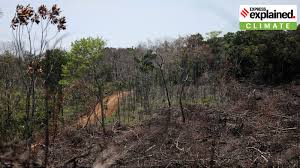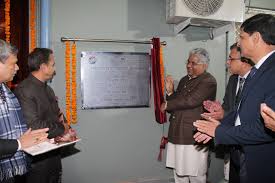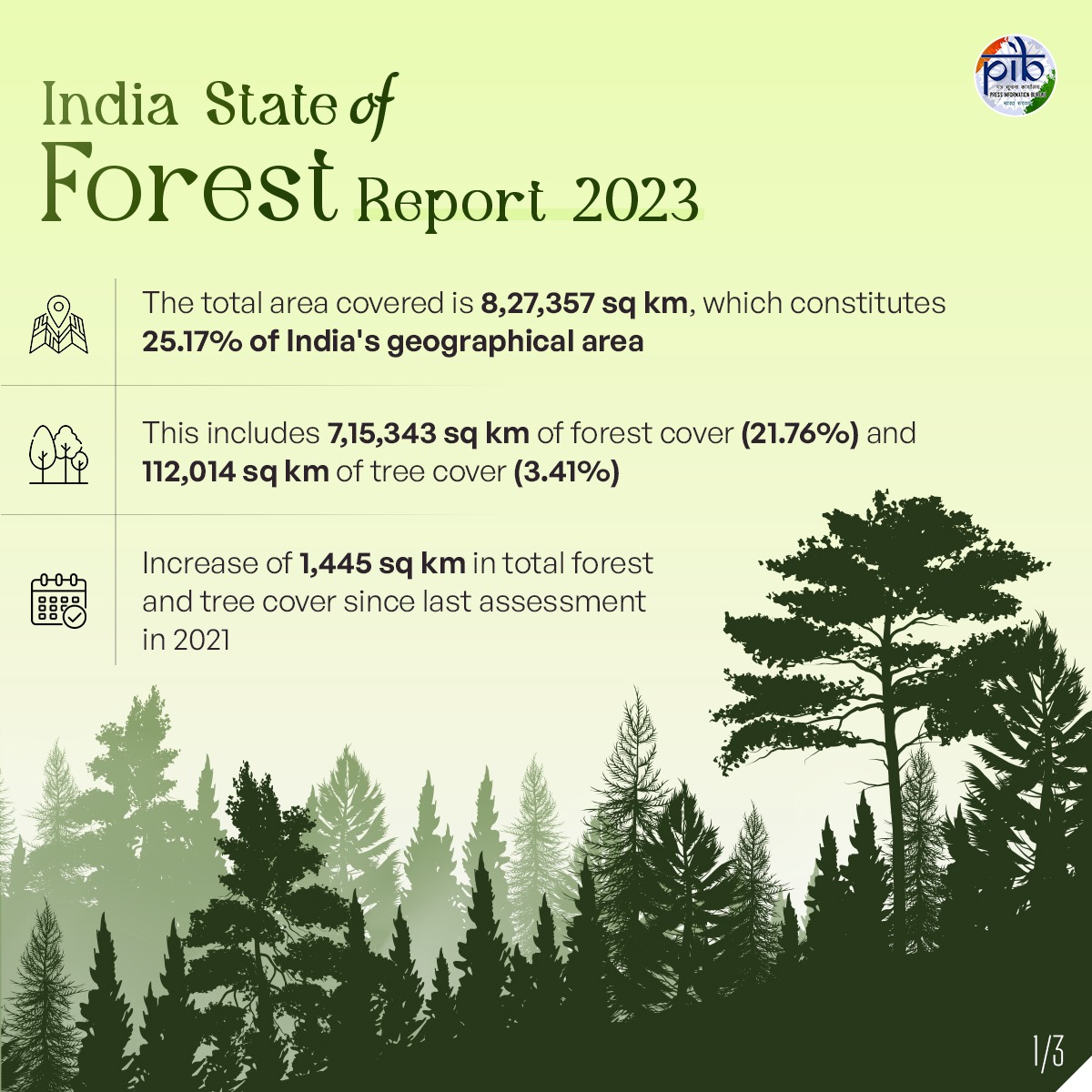IPBES Nexus Report

- 22 Dec 2024
In News:
The IPBES Nexus Report, formally titled The Assessment Report on the Interlinkages Among Biodiversity, Water, Food, and Health, was released to address the interconnected global challenges of climate change, biodiversity loss, food insecurity, water scarcity, and health risks. The report stresses that these challenges are deeply intertwined and cannot be solved separately; doing so would lead to ineffective or even counterproductive results.
Key Highlights of the Nexus Report
- Interconnections Between Global Challenges: The report emphasizes the strong interlinkages between the five major global challenges:
- Biodiversity Loss
- Water Scarcity
- Food Insecurity
- Health Risks
- Climate Change
It argues that efforts to address these challenges independently are ineffective and often exacerbate the problems. For example, scaling up food production to combat hunger can put more pressure on land, water, and biodiversity.
- Economic Cost of Biodiversity Loss:
- Global GDP Dependency: Over half of the global GDP (approximately $58 trillion annually) depends on nature. Biodiversity degradation significantly undermines productivity and economic output.
- Unaccounted Costs: The neglect of biodiversity in economic activities contributes to a loss of $10-25 trillion annually.
- Delayed Action: Delaying action on biodiversity conservation could double the costs within the next decade, potentially incurring $500 billion per year in additional costs.
- Synergistic Approach: The report identifies over 70 response options that promote synergistic outcomes across the five challenges. These include:
- Restoring Carbon-Rich Ecosystems: Such as forests, soils, and mangroves to address climate change and biodiversity loss.
- Managing Biodiversity to Prevent Disease Transmission: Effective biodiversity management reduces risks of diseases passing from animals to humans (zoonotic diseases).
- Sustainable Diets: Promoting diets that are both healthy and environmentally sustainable.
- Nature-Based Solutions: Implementing solutions that rely on natural processes to mitigate challenges like water scarcity and climate change.
- Inequality and Vulnerability: The report highlights how inequality exacerbates the challenges. Vulnerable populations, especially those living in areas where biodiversity has sharply declined, face increased health risks, malnutrition, and economic instability. 41% of people live in regions where biodiversity loss has been particularly severe, and 9% face high health burdens due to these declines.
- Principles for Transformative Change: The report outlines principles for achieving transformative change:
- Equity and Justice: Ensuring fair distribution of resources and opportunities for all.
- Pluralism and Inclusion: Embracing diverse perspectives and voices in policy-making.
- Respectful Human-Nature Relationships: Recognizing and nurturing reciprocal relationships between humans and nature.
- Adaptive Learning and Action: Continuously evolving policies and strategies based on feedback and new evidence.
- Urgency for Immediate Action: The report stresses that immediate action is critical. If the world continues to neglect biodiversity, it will face not only environmental collapse but also a missed opportunity for economic growth. Immediate implementation of nature-positive strategies could unlock $10 trillion in business opportunities and create 400 million jobs by 2030.
The IPBES Transformative Change Assessment Report
- This report builds upon the 2019 IPBES Global Assessment Report and advocates for transformative change to halt biodiversity loss and achieve global development goals. It defines transformative change as a system-wide shift in:
- Views: Changing how we think about nature and its value.
- Structures: Reforming systems of governance and organization.
- Practices: Changing behaviors and practices that harm nature.
Key Challenges to Transformative Change:
- Disconnection from Nature: Human societies' disconnection from nature, often rooted in historical domination, is a major cause of biodiversity loss.
- Economic Inequality: The concentration of power and wealth exacerbates environmental degradation.
- Unsustainable Consumption: Unsustainable patterns of consumption and production are significant drivers of environmental harm.
Synergistic Strategies for Transformation:
- Conserve and Regenerate: Restore ecosystems that have both ecological and cultural value.
- Mainstream Biodiversity: Integrate biodiversity considerations into sectors like agriculture, forestry, and infrastructure development.
- Transform Economic Systems: Adopt policies such as true cost accounting and sustainability-based tax principles to internalize the environmental costs of economic activities.
- Inclusive Governance: Promote governance systems that involve all stakeholders, especially local communities, in decision-making.
SAMARTH UDYOG BHARAT 4.0 INITIATIVE

- 22 Dec 2024
In News:
The SAMARTH Udyog Bharat 4.0 initiative, launched by the Ministry of Heavy Industries (MHI), aims to enhance the competitiveness of the Indian capital goods sector by promoting the adoption of Industry 4.0 technologies. This initiative is part of the Scheme for Enhancement of Competitiveness in the Indian Capital Goods Sector.
Key Features of SAMARTH Udyog Bharat 4.0 Initiative
- Establishment of Smart Manufacturing Hubs: Under this initiative, four Smart Advanced Manufacturing and Rapid Transformation Hub (SAMARTH) Centres have been set up across India:
- Centre for Industry 4.0 (C4i4) Lab, Pune
- IITD-AIA Foundation for Smart Manufacturing, IIT Delhi
- I-4.0 India @ IISc, Bengaluru
- Smart Manufacturing Demo & Development Cell, CMTI, Bengaluru
- Cluster Industry 4.0 Experience Centres: In addition to the above centres, 10 cluster Industry 4.0 experience centres have been approved. These will be established under a Hub and Spoke model, managed by the C4i4 Lab in Pune, and spread across India.
- Key Achievements:
- Model Factories: Development of an Industry 4.0 enabled Model Factory at C4i4, Pune, and a smart production-based factory at CMTI Bengaluru.
- Industry 4.0 Solutions: More than 50 use-cases for Industry 4.0 solutions were compiled to support implementation.
- Maturity Assessment Tool: Creation of the Industry 4.0 Maturity Model (I4MM), specifically designed to assess the readiness of Indian manufacturing companies for Industry 4.0.
- Online Assessment Tool: Launch of a free online assessment tool by C4i4 Lab, Pune, to help MSMEs evaluate their maturity in adopting Industry 4.0 technologies.
- Training and Awareness:
- Workshops and Seminars: Regular awareness seminars, workshops, and knowledge-sharing events are organized to educate industries about Industry 4.0.
- Workforce Training: The SAMARTH Centres have trained over 5000 professionals on smart manufacturing and Industry 4.0 technologies.
- Consultancy Services: The centres offer consultancy in areas such as IoT hardware, software development, and data analytics, along with incubation support for start-ups and MSMEs.
- Impact on MSMEs:
- Digital Maturity Assessments: Over 100 digital maturity assessments have been completed for the auto industry, and more than 500 improvement initiatives have been identified.
- Training and Capacity Building: Over 500 digital champions have been trained on Industry 4.0 technologies.
- Focus on MSMEs: While no direct financial assistance is provided to industries, including MSMEs, under this initiative, the SAMARTH Centres play a key role in helping them adopt Industry 4.0 technologies and build their capabilities.
Key Takeaways:
- The SAMARTH Udyog Bharat 4.0 initiative seeks to increase the global competitiveness of India's capital goods and manufacturing sectors.
- It leverages Industry 4.0 technologies such as IoT, automation, data analytics, and AI to modernize manufacturing processes.
- The initiative involves setting up 4 major Smart Manufacturing Hubs and 10 regional experience centres across the country to facilitate awareness, training, and adoption of Industry 4.0 among manufacturers, especially MSMEs.
- While it does not provide financial aid, it helps industries improve their digital maturity, trains workforce, and guides them through consultancy and workshops.
Next Generation DNA Sequencing Facility (NGS)

- 22 Dec 2024
Recently, the Union Minister Shri Bhupender Yadav inaugurated two groundbreaking facilities at the Wildlife Institute of India (WII), Dehradun: the Advanced Facility for Pashmina Certification and the Next Generation DNA Sequencing (NGS) Facility. These facilities are designed to enhance India’s capabilities in wildlife conservation and support the growth of traditional crafts like Pashmina weaving.
Key Highlights
Next Generation DNA Sequencing Facility (NGS)
The NGS facility is a cutting-edge research tool that enables the high-throughput analysis of entire genomes. This technology is pivotal in studying wildlife genetics and biodiversity by decoding millions of DNA sequences at once.
Applications in Wildlife Conservation:
- Genetic Diversity and Health: NGS helps assess the genetic diversity of species and their population health.
- Evolutionary Relationships: It aids in understanding the evolutionary history and unique adaptations of species.
- Disease Surveillance: The technology supports studying pathogen-host interactions and monitoring diseases affecting wildlife.
- Combating Illegal Wildlife Trade: NGS can help detect illegal wildlife trade and the movement of endangered species.
- Impact of Climate Change: It is crucial for studying how climate change affects genetic diversity and species survival.
This facility positions WII as a leading hub for molecular research, enabling more precise conservation efforts and studies on endangered species like tigers, elephants, and riverine dolphins.
Advanced Facility for Pashmina Certification
Launched under a Public-Private Partnership (PPP) model between WII and the Export Promotion Council for Handicrafts (EPCH), the Pashmina Certification Centre (PCC) has been significantly upgraded. The facility now includes a Scanning Electron Microscope (SEM) with Energy Dispersive Spectroscopy (EDS) for advanced wool testing and certification.
Key Features of the Upgraded Facility:
- Fiber Analysis: The SEM-EDS technology ensures accurate identification and certification of Pashmina fibers, free from any prohibited materials.
- Unique ID and E-certificates: Each certified product is tagged with a unique ID and e-certificate, enhancing traceability and authenticity.
- Global Trade Facilitation: The certification process eliminates delays at exit points, ensuring smoother international trade for certified Pashmina products.
The PCC has already certified over 15,000 Pashmina shawls and plays a crucial role in supporting the livelihoods of artisans and weavers in Jammu & Kashmir. By ensuring the authenticity of Pashmina, the facility also helps combat the illegal trade of Shahtoosh wool, which is harmful to the Tibetan antelope (Chiru).
Significance for Artisans and Conservation:
- Support for Artisans: The upgraded facility helps increase the credibility of Pashmina products in global markets, benefiting local artisans and weavers.
- Conservation Impact: By certifying genuine Pashmina products, the initiative indirectly contributes to the conservation of the Tibetan antelope by reducing illegal poaching and trade.
- Sustainability: The PCC is a self-sustaining model that not only supports conservation but also generates revenue and creates job opportunities.
Overview of the Genome India Project
The Genome India Project is a gene mapping initiative launched by the Department of Biotechnology, aiming to create a comprehensive database of genetic variations across the Indian population. The project focuses on understanding genetic diversity and its implications for health, agriculture, and biodiversity conservation in India.
Goals:
- Comprehensive Gene Mapping: The project seeks to map the genetic variations found within India’s diverse population, enabling better healthcare and disease management.
- Conservation and Biodiversity: Insights from the project will also aid in wildlife conservation by understanding the genetic health of endangered species and their ability to adapt to environmental changes.
This initiative is aligned with India’s broader goals of using advanced technologies to address modern conservation challenges and foster a sustainable future.
India State of Forest Report 2023

- 22 Dec 2024
In News:
The India State of Forest Report 2023 (ISFR 2023) was released by the Union Minister for Environment, Forest, and Climate Change at the Forest Research Institute in Dehradun. This biennial report, published by the Forest Survey of India (FSI), assesses the forest and tree resources of the country based on satellite data and field-based inventories. The ISFR 2023 is the 18th edition of this report, with the first published in 1987.
Key Findings
- Total Forest and Tree Cover:
- Area: 827,357 sq km (25.17% of India's geographical area)
- Breakdown:
- Forest cover: 715,343 sq km (21.76%)
- Tree cover: 112,014 sq km (3.41%)
- Increase from 2021: An increase of 1,445 sq km, including:
- Forest cover: +156 sq km
- Tree cover: +1,289 sq km
- State-wise Forest and Tree Cover:
- Top 3 States by Total Forest and Tree Cover Area:
- Madhya Pradesh (85,724 sq km)
- Arunachal Pradesh (67,083 sq km)
- Maharashtra (65,383 sq km)
- Top 3 States by Forest Cover:
- Madhya Pradesh (77,073 sq km)
- Arunachal Pradesh (65,882 sq km)
- Chhattisgarh (55,812 sq km)
- States with Maximum Increase in Forest and Tree Cover:
- Chhattisgarh, Uttar Pradesh, Odisha, and Rajasthan
- Mizoram, Gujarat, and Odisha showed the most significant increase in forest cover.
- Top 3 States by Total Forest and Tree Cover Area:
- Forest Cover Percentage (as a proportion of total geographical area):
- Lakshadweep: 91.33% (Highest)
- Mizoram: 85.34%
- Andaman & Nicobar Islands: 81.62%
- 19 States/UTs have over 33% forest cover, with 8 states having more than 75%.
- Mangrove Cover:
- Total Mangrove Cover: 4,992 sq km (a decrease of 7.43 sq km from 2021).
- Notable Changes: Gujarat saw the largest loss of mangroves, whereas Andhra Pradesh and Maharashtra reported increases.
- Carbon Stock and Climate Targets:
- Total Carbon Stock: 7,285.5 million tonnes (an increase of 81.5 million tonnes from the previous assessment).
- Nationally Determined Contributions (NDC):
- India’s carbon stock has reached 30.43 billion tonnes of CO2 equivalent.
- Achieved an additional 2.29 billion tonnes of carbon sink compared to the 2005 baseline, towards the 2030 target of 2.5-3.0 billion tonnes.
- Bamboo and Timber Production:
- Bamboo Bearing Area: Estimated at 154,670 sq km, an increase of 5,227 sq km since 2021.
- Timber Potential: Estimated annual potential production of 91.51 million cubic meters from trees outside forests.
Achievements:
- There has been a notable increase in the forest and tree cover, particularly in states like Chhattisgarh, Uttar Pradesh, Odisha, and Rajasthan.
- The carbon stock in forests has increased, helping India make significant progress in its climate change mitigation goals.
- The bamboo bearing area has also expanded, promoting biodiversity and economic benefits through bamboo cultivation.
Concerns:
- Mangrove Loss: Gujarat experienced a notable decrease in mangrove area, highlighting the need for focused conservation efforts in coastal regions.
Forest Survey of India (FSI) Overview
- Established: 1981, under the Ministry of Environment, Forest and Climate Change (MoEFCC).
- Mission: To assess, monitor, and research forest resources across India, providing data for sustainable management, national planning, and conservation.
- Headquarters: Dehradun, Uttarakhand.
India’s National Quantum Mission

- 22 Dec 2024
In News:
India is preparing to launch its first quantum satellite within 2-3 years as part of its National Quantum Mission (NQM), a significant initiative aimed at positioning India as a global leader in quantum technologies. This satellite will play a pivotal role in enhancing the security of communications, particularly in the face of the potential threat posed by quantum computers to existing cryptographic systems.
What is a Quantum Satellite?
A quantum satellite is a type of communication satellite that uses quantum physics principles to secure data transmission. Unlike conventional satellites that rely on classical encryption, quantum satellites leverage quantum mechanics to achieve unbreakable encryption through Quantum Key Distribution (QKD).
Key Features:
- Quantum Key Distribution (QKD): Ensures secure key sharing, revealing any attempts of eavesdropping.
- Security Advantage: Provides "unconditional security" by detecting any interference during the transmission process.
- Data Transmission: Unlike conventional satellites that encode data in classical bits, quantum satellites encode information in quantum states or qubits.
What is Quantum Cryptography?
Quantum cryptography is a technique that uses the laws of quantum mechanics to secure communications. The most widely used method is Quantum Key Distribution (QKD), which ensures that the keys used to encrypt and decrypt messages remain secret and unbreakable.
Key Mechanisms:
- Quantum Measurement: Any attempt to measure the quantum state (such as a photon carrying information) changes its state, alerting the sender and receiver to potential eavesdropping.
- Quantum Entanglement: When two quantum particles (photons) are entangled, a change in one will instantaneously affect the other, ensuring that the key remains secure.
Why is Quantum Satellite Important?
The advent of quantum computing threatens the cryptographic methods that secure current digital communications. Quantum computers, with their vast computational power, could potentially crack encryption codes that are currently deemed secure. Quantum satellites aim to counteract this threat by using quantum cryptography to make communications tamper-proof.
Security in the Quantum Era:
- Classical Encryption: Relies on mathematical problems that are difficult to solve without the decryption key.
- Quantum Encryption: Uses quantum properties, such as superposition and entanglement, to offer superior security.
National Quantum Mission (NQM)
The National Quantum Mission (NQM) was approved by the Union Cabinet in April 2023 with a budget of ?6,000 crore for implementation over eight years (2023-2031). The mission aims to accelerate the development and application of quantum technologies, with a focus on quantum communication, quantum computing, quantum sensing, and quantum metrology.
Key Objectives:
- Development of Quantum Computers: Building intermediate-scale quantum computers with 50-1000 qubits.
- Quantum Communication: Establishing secure, satellite-based quantum communication systems within India and internationally.
- Research and Innovation: Fostering quantum technologies and creating a self-reliant ecosystem.
India’s Advancements in Quantum Technology
India is making significant progress in quantum research and communication. The Raman Research Institute in Bengaluru has identified Hanle, Ladakh as an ideal location for quantum communication experiments due to its optimal atmospheric conditions.
The Indian Space Research Organisation (ISRO) has already demonstrated successful free-space quantum communication over short distances (300 meters). The upcoming quantum satellite will build upon this progress to create secure quantum communication networks within India and internationally.
Global Context: Micius Satellite and China’s Lead
China is a global leader in quantum communications, having launched the world’s first quantum satellite, Micius, in 2016. Micius demonstrated the feasibility of secure quantum communication by generating pairs of entangled photons. India’s quantum satellite will build on this technology to create robust, long-range quantum communication networks.
Limitations of Quantum Key Distribution (QKD)
Despite its promise, QKD faces several limitations:
- Technological Maturity: The technology is still in the experimental phase, and large-scale commercial implementation is not yet feasible.
- Authentication Issues: QKD lacks reliable methods to authenticate the transmission source, leaving it vulnerable to impersonation attacks.
- Infrastructure Costs: Establishing and maintaining QKD networks requires specialized hardware, leading to higher costs.
- Denial-of-Service Risks: Eavesdroppers can trigger the abort mechanism, leading to transmission interruptions.
- Signal Loss: Atmospheric and distance-related attenuation can degrade the quality of quantum signals.
National Quantum Mission and Sectoral Impact
The NQM aligns with India's national priorities, including Digital India, Make in India, and Start-up India. The mission’s outcomes are expected to impact various sectors, such as:
- Healthcare: Quantum computing for drug design and medical research.
- Space Exploration: Enhancing communication security for space missions.
- Banking and Financial Services: Strengthening data security and transaction integrity.
- Energy: Improving energy systems and smart grids through advanced sensing technologies.
